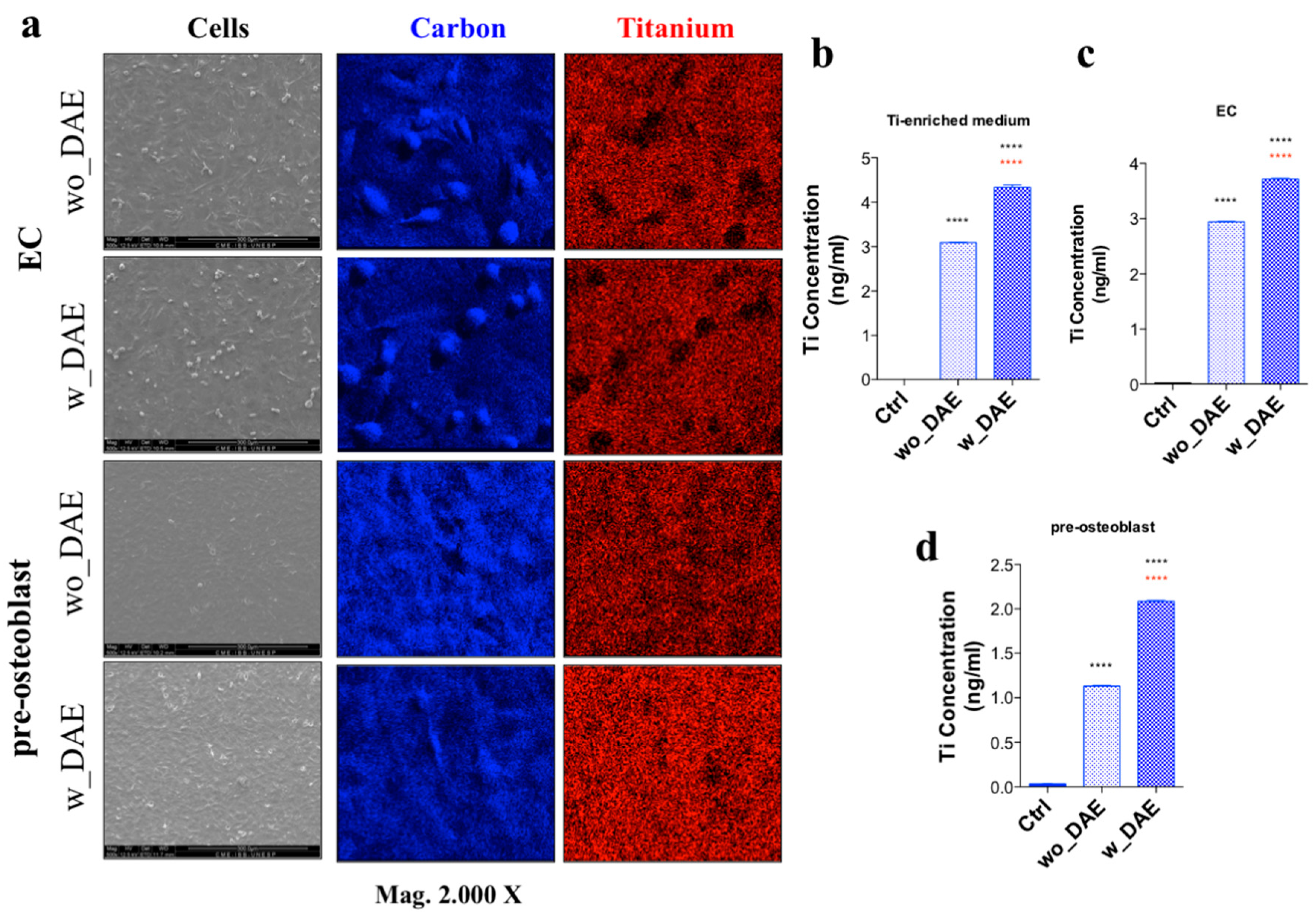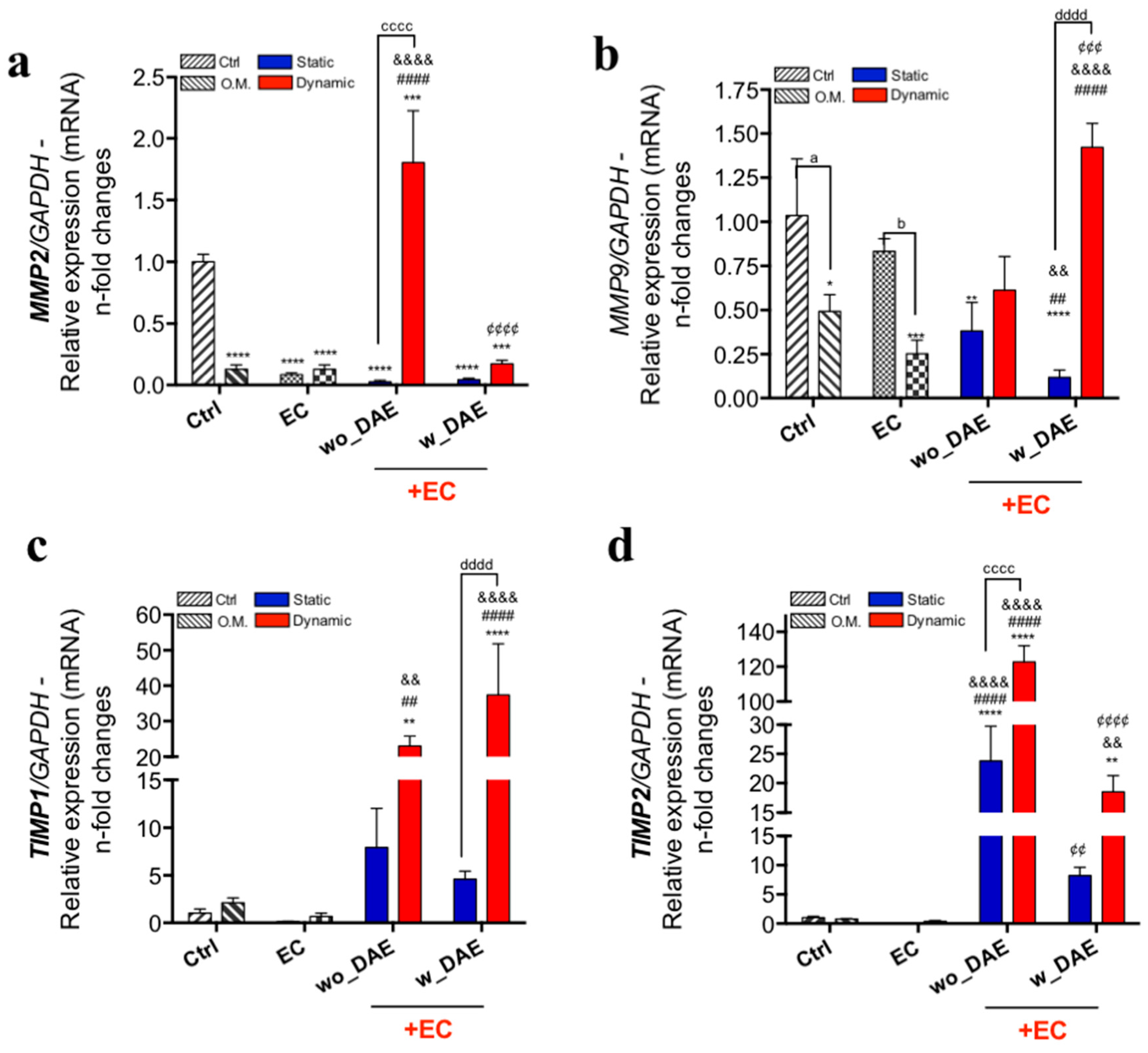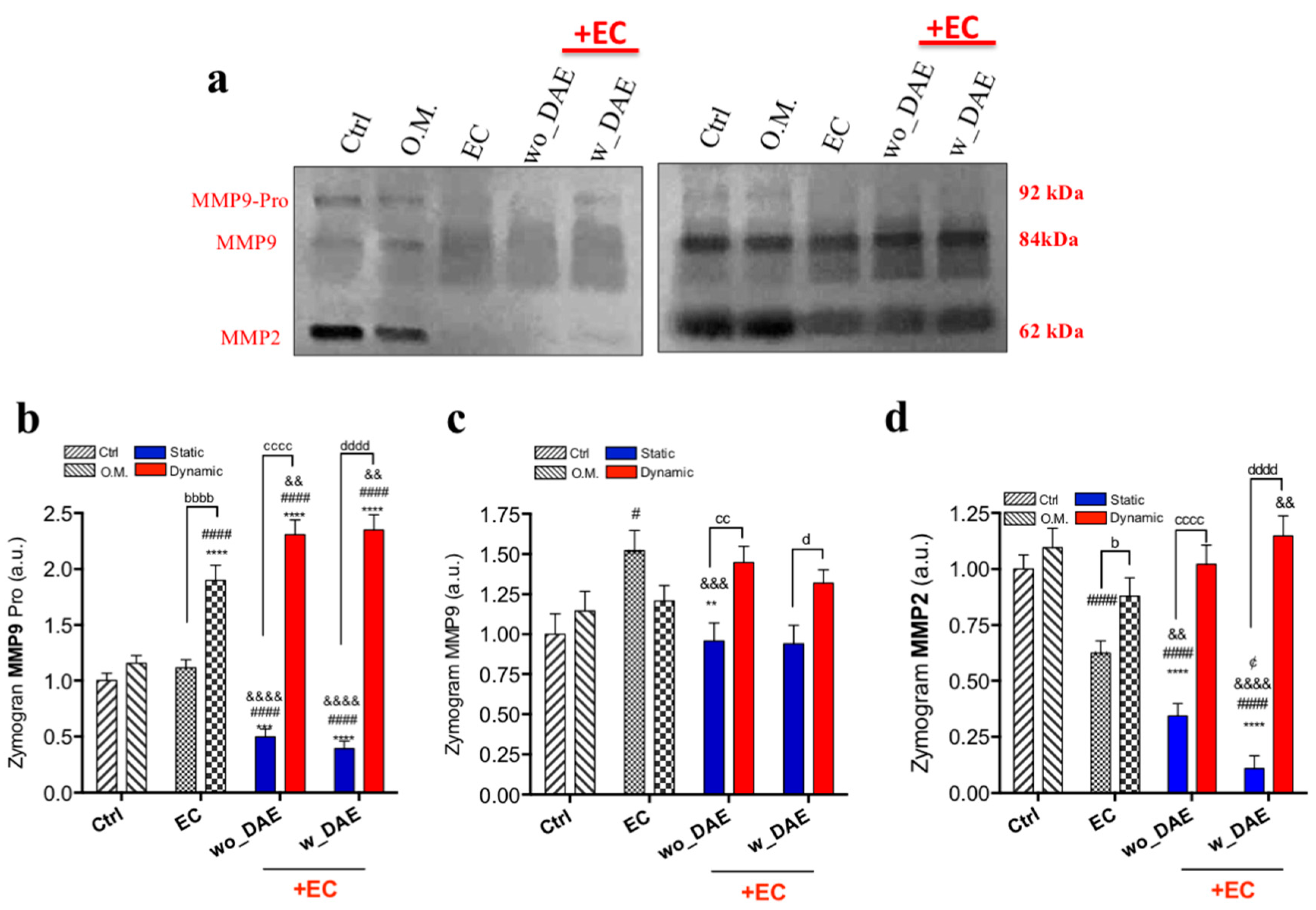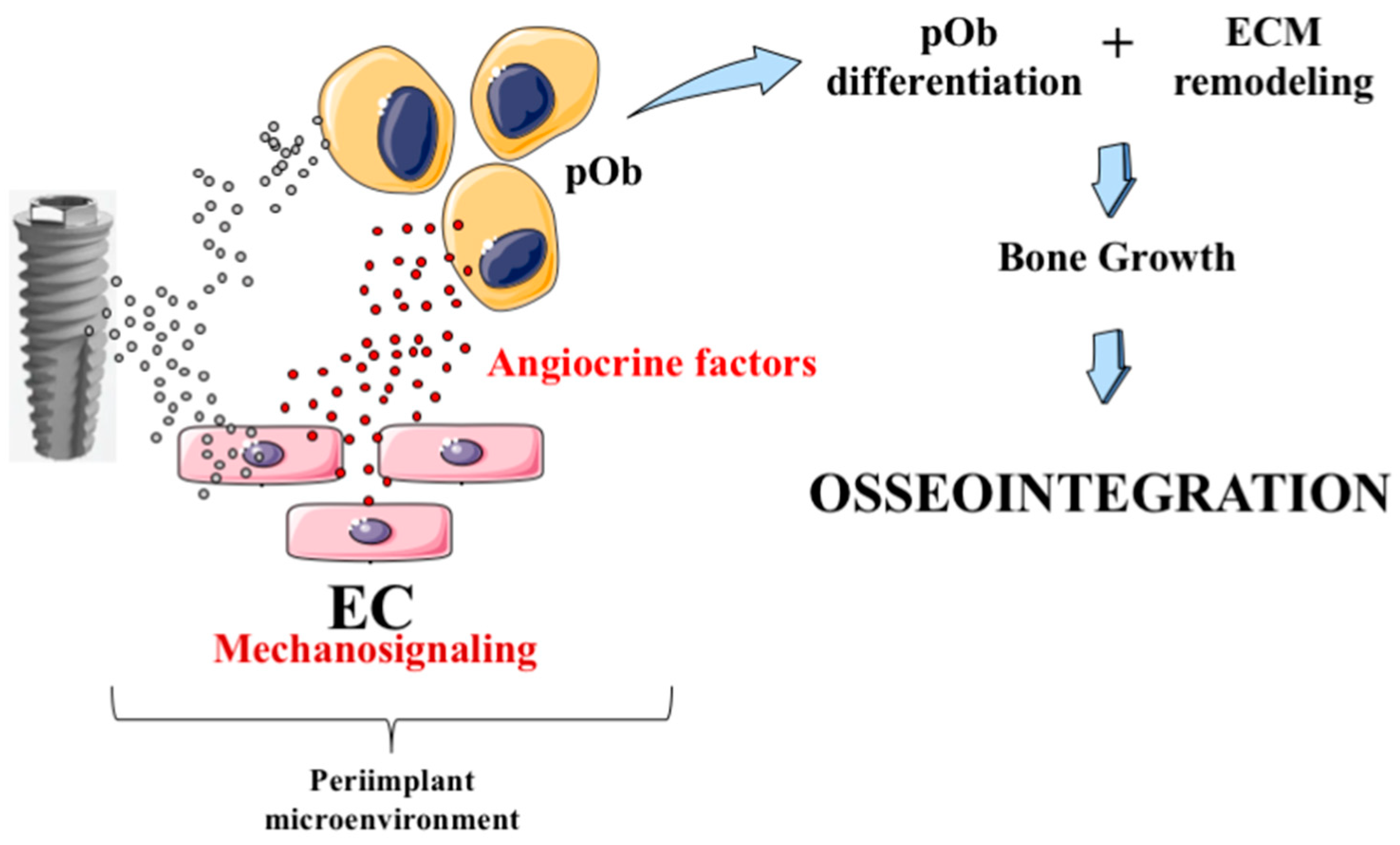The Action of Angiocrine Molecules Sourced from Mechanotransduction-Related Endothelial Cell Partially Explain the Successful of Titanium in Osseointegration
Abstract
1. Introduction
2. Materials and Methods
2.1. Materials and Titanium Alloys
2.2. Cell Culture
2.3. Preparation of Angiocrine Molecules-Obtaining Medium
2.4. The Laminar Shear-Stress Model Was Applied to Mimic Mechanotransduction-Related Endothelial Cell Signaling Related to Blood Flow
2.5. Titanium Content Was Quantified with GFAAS
2.6. mRNA Isolation and qPCR Analysis
2.7. Scanning Electron Microscopy (SEM) and Energy Dispersive X-ray (EDX)
2.8. Gelatin Proteolysis-Based Zymography
2.9. Statistical Analysis
3. Results
3.1. Dynamic Interaction of Titanium Surface with the Microenvironment
3.2. In Conjunction, Angiocrine Soluble Factors and Titanium Promote Osteogenic Gene Markers’ Requirements
3.3. Mechanotransduction-Related Endothelial Cell Signaling Drives Angiocrine Molecules Requiring Col3A1 and the Profile of ECM Remodeling in Differentiating Osteoblasts
4. Discussion
5. Conclusions
Author Contributions
Funding
Data Availability Statement
Acknowledgments
Conflicts of Interest
References
- Gemini-Piperni, S.; Takamori, E.R.; Sartoretto, S.C.; Paiva, K.B.; Granjeiro, J.M.; de Oliveira, R.C.; Zambuzzi, W.F. Cellular behavior as a dynamic field for exploring bone bioengineering: A closer look at cell–biomaterial interface. Arch. Biochem. Biophys. 2014, 561, 88–98. [Google Scholar] [CrossRef] [PubMed]
- Zambuzzi, W.F.; Coelho, P.G.; Alves, G.G.; Granjeiro, J.M. Intracellular Signal Transduction as a Factor in the Development of “Smart” Biomaterials for Bone Tissue Engineering; John Wiley & Sons, Ltd.: Hoboken, NJ, USA, 2011; Volume 108, pp. 1246–1250. [Google Scholar]
- Castro-Silva, I.I.; Zambuzzi, W.F.; de Oliveira Castro, L.; Granjeiro, J.M. Periosteal-Derived Cells for Bone Bioengineering: A Promising Candidate. Available online: https://pubmed.ncbi.nlm.nih.gov/22221259/ (accessed on 3 March 2023).
- Bezerra, F.; Ferreira, M.R.; Fontes, G.N.; Fernandes, C.J.D.C.; Andia, D.C.; Cruz, N.C.; da Silva, R.A.; Zambuzzi, W.F. Nano hydroxyapatite-blasted titanium surface affects pre-osteoblast morphology by modulating critical intracellular pathways. Biotechnol. Bioeng. 2017, 114, 1888–1898. [Google Scholar] [CrossRef] [PubMed]
- Zambuzzi, W.F.; Bonfante, E.A.; Jimbo, R.; Hayashi, M.; Andersson, M.; Alves, G.; Takamori, E.R.; Beltrão, P.J.; Coelho, P.G.; Granjeiro, J.M. Nanometer Scale Titanium Surface Texturing Are Detected by Signaling Pathways Involving Transient FAK and Src Activations. PLoS ONE 2014, 9, e95662. [Google Scholar] [CrossRef]
- Feltran, G.; Bezerra, F.; Fernandes, C.J.D.C.; Ferreira, M.; Zambuzzi, W.F. Differential inflammatory landscape stimulus during titanium surfaces obtained osteogenic phenotype. J. Biomed. Mater. Res. Part A 2019, 107, 1597–1604. [Google Scholar] [CrossRef] [PubMed]
- de Oliveira, P.G.F.P.; Bonfante, E.A.; Bergamo, E.T.; de Souza, S.L.S.; Riella, L.; Torroni, A.; Jalkh, E.B.B.; Witek, L.; Lopez, C.D.; Zambuzzi, W.F.; et al. Obesity/Metabolic Syndrome and Diabetes Mellitus on Peri-implantitis. Trends Endocrinol. Metab. 2020, 31, 596–610. [Google Scholar] [CrossRef]
- Granato, R.; Bergamo, E.T.; Witek, L.; Bonfante, E.A.; Marin, C.; Greenberg, M.; Kurgansky, G.; Coelho, P.G. Clinical, histological, and nanomechanical parameters of implants placed in healthy and metabolically compromised patients. J. Dent. 2020, 100, 103436. [Google Scholar] [CrossRef]
- Fernandes, C.J.; Bezerra, F.; Ferreira, M.R.; Andrade, A.F.; Pinto, T.S.; Zambuzzi, W.F. Nano hydroxyapatite-blasted titanium surface creates a biointerface able to govern Src-dependent osteoblast metabolism as prerequisite to ECM remodeling. Colloids Surfaces B Biointerfaces 2018, 163, 321–328. [Google Scholar] [CrossRef]
- Fernandes, C.J.C.; Bezerra, F.; Carmo, M.D.D.D.; Feltran, G.S.; Rossi, M.C.; da Silva, R.A.; Padilha, P.D.M.; Zambuzzi, W.F. CoCr-enriched medium modulates integrin-based downstream signaling and requires a set of inflammatory genes reprograming in vitro. J. Biomed. Mater. Res. Part A 2018, 106, 839–849. [Google Scholar] [CrossRef]
- Fernandes, C.J.D.C.; Ferreira, M.R.; Bezerra, F.J.B.; Zambuzzi, W.F. Zirconia stimulates ECM-remodeling as a prerequisite to pre-osteoblast adhesion/proliferation by possible interference with cellular anchorage. J. Mater. Sci. Mater. Med. 2018, 29, 41. [Google Scholar] [CrossRef]
- Kusumbe, A.P.; Ramasamy, S.K.; Adams, R.H. Coupling of angiogenesis and osteogenesis by a specific vessel subtype in bone. Nature 2014, 507, 323–328. [Google Scholar] [CrossRef]
- Meirelles, L.; Arvidsson, A.; Andersson, M.; Kjellin, P.; Albrektsson, T.; Wennerberg, A. Nano hydroxyapatite structures influence early bone formation. J. Biomed. Mater. Res. Part A 2008, 87, 299–307. [Google Scholar] [CrossRef]
- Camargo, W.A.; Takemoto, S.; Hoekstra, J.W.; Leeuwenburgh, S.C.; Jansen, J.A.; Beucken, J.J.V.D.; Alghamdi, H.S. Effect of surface alkali-based treatment of titanium implants on ability to promote in vitro mineralization and in vivo bone formation. Acta Biomater. 2017, 57, 511–523. [Google Scholar] [CrossRef] [PubMed]
- Hamada, K.; Kon, M.; Hanawa, T.; Yokoyama, K.; Miyamoto, Y.; Asaoka, K. Hydrothermal modification of titanium surface in calcium solutions. Biomaterials 2002, 23, 2265–2272. [Google Scholar] [CrossRef] [PubMed]
- Gomes, O.; Feltran, G.; Ferreira, M.; Albano, C.; Zambuzzi, W.; Lisboa-Filho, P. A novel BSA immobilizing manner on modified titanium surface ameliorates osteoblast performance. Colloids Surfaces B Biointerfaces 2020, 190, 110888. [Google Scholar] [CrossRef]
- Albano, C.S.; Gomes, A.M.; Feltran, G.D.S.; Fernandes, C.J.D.C.; Trino, L.D.; Zambuzzi, W.F.; Lisboa-Filho, P.N. Bisphosphonate-based surface biofunctionalization improves titanium biocompatibility. J. Mater. Sci. Mater. Med. 2020, 31, 109. [Google Scholar] [CrossRef]
- Ferreira, M.R.; Milani, R.; Rangel, E.C.; Peppelenbosch, M.; Zambuzzi, W. OsteoBLAST: Computational Routine of Global Molecular Analysis Applied to Biomaterials Development. Front. Bioeng. Biotechnol. 2020, 8, 565901. [Google Scholar] [CrossRef]
- Martins, M.L.; Pinto, T.S.; Gomes, A.M.; Parra, J.P.R.L.L.; Franchi, G.C.; Zambuzzi, W.F.; Rodrigues, C.G. Immobilization of Paclitaxel on Hydroxyapatite for Breast Cancer Investigations. Available online: https://pubmed.ncbi.nlm.nih.gov/32643936/ (accessed on 8 February 2023).
- Ribeiro, A.; Oliveira, F.; Boldrini, L.; Leite, P.; Falagan-Lotsch, P.; Linhares, A.; Zambuzzi, W.; Fragneaud, B.; Campos, A.; Gouvêa, C.; et al. Micro-arc oxidation as a tool to develop multifunctional calcium-rich surfaces for dental implant applications. Mater. Sci. Eng. C 2015, 54, 196–206. [Google Scholar] [CrossRef]
- Luo, B.-H.; Carman, C.V.; Springer, T.A. Structural Basis of Integrin Regulation and Signaling. Annu. Rev. Immunol. 2007, 25, 619–647. [Google Scholar] [CrossRef]
- Milani, R.; Ferreira, C.V.; Granjeiro, J.M.; Paredes-Gamero, E.J.; Silva, R.A.; Justo, G.Z.; Nader, H.B.; Galembeck, E.; Peppelenbosch, M.P.; Aoyama, H.; et al. Phosphoproteome reveals an atlas of protein signaling networks during osteoblast adhesion. J. Cell. Biochem. 2010, 109, 957–966. [Google Scholar] [CrossRef]
- Kim, S.-H.; Turnbull, J.; Guimond, S. Extracellular matrix and cell signalling: The dynamic cooperation of integrin, proteoglycan and growth factor receptor. J. Endocrinol. 2011, 209, 139–151. [Google Scholar] [CrossRef] [PubMed]
- Bertazzo, S.; Zambuzzi, W.F.; da Silva, H.A.; Ferreira, C.V.; Bertran, C.A. Bioactivation of alumina by surface modification: A possibility for improving the applicability of alumina in bone and oral repair. Clin. Oral Implant. Res. 2009, 20, 288–293. [Google Scholar] [CrossRef] [PubMed]
- Zambuzzi, W.F.; Bruni-Cardoso, A.; Granjeiro, J.M.; Peppelenbosch, M.P.; de Carvalho, H.F.; Aoyama, H.; Ferreira, C.V. On the road to understanding of the osteoblast adhesion: Cytoskeleton organization is rearranged by distinct signaling pathways. J. Cell. Biochem. 2009, 108, 134–144. [Google Scholar] [CrossRef] [PubMed]
- Zambuzzi, W.F.; Milani, R.; Teti, A. Expanding the Role of Src and Protein-Tyrosine Phosphatases Balance in Modulating Osteoblast Metabolism: Lessons from Mice; Elsevier: Amsterdam, The Netherlands, 2010; Volume 92, pp. 327–332. [Google Scholar]
- Bertazzo, S.; Zambuzzi, W.F.; Campos, D.D.; Ogeda, T.L.; Ferreira, C.V.; Bertran, C.A. Hydroxyapatite surface solubility and effect on cell adhesion. Colloids Surfaces B Biointerfaces 2010, 78, 177–184. [Google Scholar] [CrossRef]
- Fernandes, G.V.O.; Cavagis, A.D.M.; Ferreira, C.V.; Olej, B.; Leão, M.d.S.; Yano, C.L.; Peppelenbosch, M.; Granjeiro, J.M.; Zambuzzi, W.F. Osteoblast Adhesion Dynamics: A Possible Role for ROS and LMW-PTP. J. Cell. Biochem. 2014, 115, 1063–1069. [Google Scholar] [CrossRef] [PubMed]
- Fabry, B.; Klemm, A.H.; Kienle, S.; Schäffer, T.E.; Goldmann, W.H. Focal Adhesion Kinase Stabilizes the Cytoskeleton. Biophys. J. 2011, 101, 2131–2138. [Google Scholar] [CrossRef]
- Liao, X.; Lu, S.; Wu, Y.; Xu, W.; Zhuo, Y.; Peng, Q.; Li, B.; Zhang, L.; Wang, Y. The Effect of Differentiation Induction on FAK and Src Activity in Live HMSCs Visualized by FRET. PLoS ONE 2013, 8, e72233. [Google Scholar] [CrossRef]
- Tokuhara, C.K.; Santesso, M.R.; de Oliveira, G.S.N.; Ventura, T.M.d.S.; Doyama, J.T.; Zambuzzi, W.F.; de Oliveira, R.C. Updating the role of matrix metalloproteinases in mineralized tissue and related diseases. J. Appl. Oral Sci. 2019, 27, e20180596. [Google Scholar] [CrossRef]
- Fernandes, C.J.D.C.; Bezerra, F.J.; Souza, B.D.C.; Campos, M.A.; Zambuzzi, W.F. Titanium-enriched medium drives low profile of ECM remodeling as a pre-requisite to pre-osteoblast viability and proliferative phenotype. J. Trace Elements Med. Biol. 2018, 50, 339–346. [Google Scholar] [CrossRef]
- Pinto, T.S.; Martins, B.R.; Ferreira, M.R.; Bezerra, F.; Zambuzzi, W.F. Nanohydroxyapatite-Blasted Bioactive Surface Drives Shear-Stressed Endothelial Cell Growth and Angiogenesis. BioMed Res. Int. 2022, 2022, 1433221. [Google Scholar] [CrossRef]
- Martins, B.R.; Pinto, T.S.; Fernandes, C.J.D.C.; Bezerra, F.; Zambuzzi, W.F. PI3K/AKT signaling drives titanium-induced angiogenic stimulus. J. Mater. Sci. Mater. Med. 2021, 32, 18. [Google Scholar] [CrossRef]
- Yu, X.; Tang, X.; Gohil, S.V.; Laurencin, C.T. Biomaterials for Bone Regenerative Engineering. Adv. Healthc. Mater. 2015, 4, 1268–1285. [Google Scholar] [CrossRef] [PubMed]
- Rossi, M.C.; Bezerra, F.J.B.; Silva, R.A.; Crulhas, B.P.; Fernandes, C.J.C.; Nascimento, A.S.; Pedrosa, V.A.; Padilha, P.; Zambuzzi, W.F. Titanium-released from dental implant enhances pre-osteoblast adhesion by ROS modulating crucial intracellular pathways. J. Biomed. Mater. Res. Part A 2017, 105, 2968–2976. [Google Scholar] [CrossRef] [PubMed]
- Fernandes, C.J.D.C.; de Almeida, G.S.; Pinto, T.S.; Teixeira, S.A.; Bezerra, F.J.; Zambuzzi, W.F. Metabolic effects of CoCr-enriched medium on shear-stressed endothelial cell and osteoblasts: A possible mechanism involving a hypoxic condition on bone healing. Mater. Sci. Eng. C 2021, 128, 112353. [Google Scholar] [CrossRef] [PubMed]
- Abe, J.-I.; Berk, B.C. Novel Mechanisms of Endothelial Mechanotransduction. Arter. Thromb. Vasc. Biol. 2014, 34, 2378–2386. [Google Scholar] [CrossRef] [PubMed]
- Paz, N.G.D.; Walshe, T.E.; Leach, L.L.; Saint-Geniez, M.; D’Amore, P.A. Role of shear-stress-induced VEGF expression in endothelial cell survival. J. Cell Sci. 2012, 125, 831–843. [Google Scholar] [CrossRef]
- Pinto, T.S.; Fernandes, C.J.D.C.; da Silva, R.A.; Gomes, A.M.; Vieira, J.C.S.; Padilha, P.D.M.; Zambuzzi, W.F. c-Src kinase contributes on endothelial cells mechanotransduction in a heat shock protein 70-dependent turnover manner. J. Cell. Physiol. 2018, 234, 11287–11303. [Google Scholar] [CrossRef]
- da Silva, R.A.; Fernandes, C.J.d.C.; Feltran, G.d.S.; Gomes, A.M.; Andrade, A.F.d.C.; Andia, D.C.; Peppelenbosch, M.P.; Zambuzzi, W.F. Laminar shear stress-provoked cytoskeletal changes are mediated by epigenetic reprogramming of TIMP1 in human primary smooth muscle cells. J. Cell. Physiol. 2019, 234, 6382–6396. [Google Scholar] [CrossRef]
- Silva, F.A.; Padilha, C.C.F.; Pezzato, L.E.; Barros, M.M.; Padilha, P.M. Determination of chromium by GFAAS in slurries of fish feces to estimate the apparent digestibility of nutrients in feed used in pisciculture. Talanta 2006, 69, 1025–1030. [Google Scholar] [CrossRef]
- Hartree, E. Determination of protein: A modification of the lowry method that gives a linear photometric response. Anal. Biochem. 1972, 48, 422–427. [Google Scholar] [CrossRef]
- Lefebvre, V.; Peeters-Joris, C.; Vaes, G. Production of Gelatin-Degrading Matrix Metalloproteinases (‘type IV Collagenases’) and Inhibitors by Articular Chondrocytes during Their Dedifferentiation by Serial Subcultures and under Stimulation by Interleukin-1 and Tumor Necrosis Factor Alpha. Biochim. Biophys. Acta 1991, 1094, 8–18. [Google Scholar] [CrossRef]
- Sartoretto, S.C.; Calasans-Maia, M.D.; Alves, A.T.N.N.; Resende, R.F.B.; da Costa Fernandes, C.J.; de Magalhães Padilha, P.; Rossi, A.M.; Teti, A.; Granjeiro, J.M.; Zambuzzi, W.F. The Role of Apoptosis Associated Speck-like Protein Containing a Caspase-1 Recruitment Domain (ASC) in Response to Bone Substitutes. Available online: https://pubmed.ncbi.nlm.nih.gov/32409093/ (accessed on 22 March 2022).
- Gemini-Piperni, S.; Milani, R.; Bertazzo, S.; Peppelenbosch, M.; Takamori, E.R.; Granjeiro, J.M.; Ferreira, C.V.; Teti, A.; Zambuzzi, W. Kinome Profiling of Osteoblasts on Hydroxyapatite Opens New Avenues on Biomaterial Cell Signaling; John Wiley and Sons Inc.: Hoboken, NJ, USA, 2014; Volume 111, pp. 1900–1905. [Google Scholar]
- Zambuzzi, W.F.; Ferreira, C.V.; Granjeiro, J.M.; Aoyama, H. Biological behavior of pre-osteoblasts on natural hydroxyapatite: A study of signaling molecules from attachment to differentiation. J. Biomed. Mater. Res. Part A 2011, 97A, 193–200. [Google Scholar] [CrossRef]
- Bertazzo, S.; Zambuzzi, W.F.; Campos, D.D.P.; Ferreira, C.V.; Bertran, C.A. A simple method for enhancing cell adhesion to hydroxyapatite surface. Clin. Oral Implant. Res. 2010, 21, 1411–1413. [Google Scholar] [CrossRef]
- Zambuzzi, W.F.; Paiva, K.B.S.; Menezes, R.; Oliveira, R.C.; Taga, R.; Granjeiro, J.M. MMP-9 and CD68+ cells are required for tissue remodeling in response to natural hydroxyapatite. Histochem. J. 2009, 40, 301–309. [Google Scholar] [CrossRef]
- Ramasamy, S.K.; Kusumbe, A.P.; Wang, L.; Adams, R.H. Endothelial Notch activity promotes angiogenesis and osteogenesis in bone. Nature 2014, 507, 376–380. [Google Scholar] [CrossRef] [PubMed]
- da Silva, R.A.; Feltran, G.D.S.; Ferreira, M.R.; Wood, P.F.; Bezerra, F.; Zambuzzi, W.F. The Impact of Bioactive Surfaces in the Early Stages of Osseointegration: An In Vitro Comparative Study Evaluating the HAnano® and SLActive® Super Hydrophilic Surfaces. BioMed Res. Int. 2020, 2020, 3026893. [Google Scholar] [CrossRef]
- Albano, C.S.; Gomes, A.M.; Feltran, G.D.S.; Fernandes, C.J.D.C.; Trino, L.D.; Zambuzzi, W.F.; Lisboa-Filho, P.N. Biofunctionalization of titanium surfaces with alendronate and albumin modulates osteoblast performance. Heliyon 2020, 6, e04455. [Google Scholar] [CrossRef] [PubMed]
- Ferreira, C.V.; Justo, G.Z.; Souza, A.C.; Queiroz, K.C.; Zambuzzi, W.F.; Aoyama, H.; Peppelenbosch, M.P. Natural compounds as a source of protein tyrosine phosphatase inhibitors: Application to the rational design of small-molecule derivatives. Biochimie 2006, 88, 1859–1873. [Google Scholar] [CrossRef]
- Komori, T. Whole Aspect of Runx2 Functions in Skeletal Development. Int. J. Mol. Sci. 2022, 23, 5776. [Google Scholar] [CrossRef] [PubMed]
- Huang, W.; Yang, S.; Shao, J.; Li, Y.P. Signaling and transcriptional regulation in osteoblast commitment and differentiation. Front. Biosci. 2007, 12, 3068–3092. [Google Scholar] [CrossRef] [PubMed]
- Zambuzzi, W.F.; Yano, C.L.; Cavagis, A.D.M.; Peppelenbosch, M.P.; Granjeiro, J.M.; Ferreira, C.V. Ascorbate-induced osteoblast differentiation recruits distinct MMP-inhibitors: RECK and TIMP-2. Mol. Cell. Biochem. 2009, 322, 143–150. [Google Scholar] [CrossRef]
- Zambuzzi, W.F.; Granjeiro, J.M.; Parikh, K.; Yuvaraj, S.; Peppelenbosch, M.P.; Ferreira, C.V. Modulation of Src Activity by Low Molecular Weight Protein Tyrosine Phosphatase During Osteoblast Differentiation. Cell. Physiol. Biochem. 2008, 22, 497–506. [Google Scholar] [CrossRef] [PubMed]
- Fernandes, C.J.D.C.; Zambuzzi, W.F. Fibroblast-secreted trophic factors contribute with ECM remodeling stimulus and upmodulate osteocyte gene markers in osteoblasts. Biochimie 2020, 168, 92–99. [Google Scholar] [CrossRef]
- Demarchi, A.C.C.d.O.; Zambuzzi, W.F.; Paiva, K.B.S.; Silva-Valenzuela, M.d.G.d.; Nunes, F.D.; Figueira, R.d.C.S.; Sasahara, R.M.; Demasi, M.A.A.; Winnischofer, S.M.B.; Sogayar, M.C.; et al. Development of secondary palate requires strict regulation of ECM remodeling: Sequential distribution of RECK, MMP-2, MMP-3, and MMP-9. Cell Tissue Res. 2010, 340, 61–69. [Google Scholar] [CrossRef] [PubMed]
- Volk, S.W.; Shah, S.R.; Cohen, A.J.; Wang, Y.; Brisson, B.K.; Vogel, L.K.; Hankenson, K.D.; Adams, S.L. Type III Collagen Regulates Osteoblastogenesis and the Quantity of Trabecular Bone. Calcif. Tissue Int. 2014, 94, 621–631. [Google Scholar] [CrossRef]
- Chang, P.-C.; Lang, N.P.; Giannobile, W.V. Evaluation of functional dynamics during osseointegration and regeneration associated with oral implants. Clin. Oral Implant. Res. 2010, 21, 1–12. [Google Scholar] [CrossRef] [PubMed]








| Gene | Primer | 5′-3′ Sequence | Work Conditions |
|---|---|---|---|
| Runx2 | Forward | GGACGAGGCAAGAGTTTCA | 95 °C—15 s; 60 °C—30 s; 72 °C—60 s |
| Reverse | TGGTGCAGAGTTCAGGGAG | ||
| Osterix | Forward | CCCTTCCCTCACTCATTTCC | 95 °C—15 s; 60 °C—30 s; 72 °C—60 s |
| Reverse | CAACCGCCTTGGGCTTAT | ||
| ALP | Forward | GAAGTCCGTGGGCATCGT | 95 °C—15 s; 60 °C—30 s; 72 °C—60 s |
| Reverse | CAGTGCGGTTCCAGACATAG | ||
| Osteocalcin | Forward | AGACTCCGGCGCTACCTT | 95 °C—15 s; 60 °C—30 s; 72 °C—60 s |
| Reverse | CTCGTCACAAGCAGGGTTAAG | ||
| BSP | Forward | GTACCGGCCACGCTACTTTCT | 95 °C—15 s; 60 °C—30 s; 72 °C—60 s |
| Reverse | GTTGACCGCCAGCTCGTTTT | ||
| Col1a1 | Forward | ATGACGTGATCTGTGACGAGAC | 95 °C—15 s; 60 °C—30 s; 72 °C—60 s |
| Reverse | TTCTTGGTCGGTGGGTGAC | ||
| Col3a1 | Forward | GACCTGAAATTCTGCCATCC | 95 °C—15 s; 60 °C—30 s; 72 °C—60 s |
| Reverse | GCATGTTTCCCCAGTTTCC | ||
| Mmp2 | Forward | AACTTTGAGAAGGATGGCAAGT | 95 °C—15 s; 60 °C—30 s; 72 °C—60 s |
| Reverse | TGCCACCCATGGTAAACAA | ||
| Mmp9 | Forward | TGTGCCCTGGAACTCACACGAC | 95 °C—15 s; 60 °C—30 s; 72 °C—60 s |
| Reverse | ACGTCGTCCACCTGGTTCACCT | ||
| Timp1 | Forward | ATCCTCTTGTTGCTATCACTG | 95 °C—15 s; 60 °C—30 s; 72 °C—60 s |
| Reverse | GGTCTCGTTGATTTCTGGG | ||
| Timp2 | Forward | GCAACAGGCGTTTTGCAATG | 95 °C—15 s; 60 °C—30 s; 72 °C—60 s |
| Reverse | CGGAATCCACCTCCTTCTCG | ||
| Gapdh | Forward | AGGCCGGTGCTGAGTATGTC | 95 °C—15 s; 60 °C—30 s; 72 °C—60 s |
| Reverse | TGCCTGCTTC ACCACCTTCT |
Disclaimer/Publisher’s Note: The statements, opinions and data contained in all publications are solely those of the individual author(s) and contributor(s) and not of MDPI and/or the editor(s). MDPI and/or the editor(s) disclaim responsibility for any injury to people or property resulting from any ideas, methods, instructions or products referred to in the content. |
© 2023 by the authors. Licensee MDPI, Basel, Switzerland. This article is an open access article distributed under the terms and conditions of the Creative Commons Attribution (CC BY) license (https://creativecommons.org/licenses/by/4.0/).
Share and Cite
Wood, P.F.; da Costa Fernandes, C.J.; de Almeida, G.S.; Suter, L.C.; de Lima Parra, J.P.R.L.; Bezerra, F.J.; Zambuzzi, W.F. The Action of Angiocrine Molecules Sourced from Mechanotransduction-Related Endothelial Cell Partially Explain the Successful of Titanium in Osseointegration. J. Funct. Biomater. 2023, 14, 415. https://doi.org/10.3390/jfb14080415
Wood PF, da Costa Fernandes CJ, de Almeida GS, Suter LC, de Lima Parra JPRL, Bezerra FJ, Zambuzzi WF. The Action of Angiocrine Molecules Sourced from Mechanotransduction-Related Endothelial Cell Partially Explain the Successful of Titanium in Osseointegration. Journal of Functional Biomaterials. 2023; 14(8):415. https://doi.org/10.3390/jfb14080415
Chicago/Turabian StyleWood, Patricia Fretes, Célio Junior da Costa Fernandes, Gerson Santos de Almeida, Luisa Camilo Suter, João Paulo Ruiz Lucio de Lima Parra, Fábio José Bezerra, and Willian Fernando Zambuzzi. 2023. "The Action of Angiocrine Molecules Sourced from Mechanotransduction-Related Endothelial Cell Partially Explain the Successful of Titanium in Osseointegration" Journal of Functional Biomaterials 14, no. 8: 415. https://doi.org/10.3390/jfb14080415
APA StyleWood, P. F., da Costa Fernandes, C. J., de Almeida, G. S., Suter, L. C., de Lima Parra, J. P. R. L., Bezerra, F. J., & Zambuzzi, W. F. (2023). The Action of Angiocrine Molecules Sourced from Mechanotransduction-Related Endothelial Cell Partially Explain the Successful of Titanium in Osseointegration. Journal of Functional Biomaterials, 14(8), 415. https://doi.org/10.3390/jfb14080415







